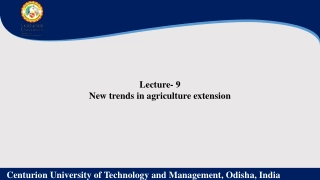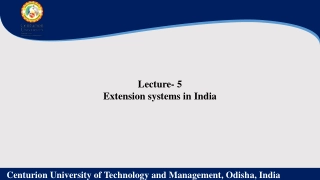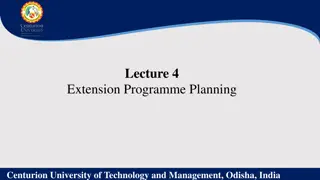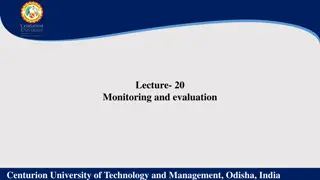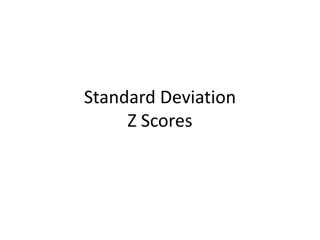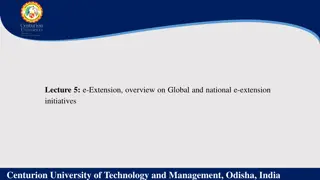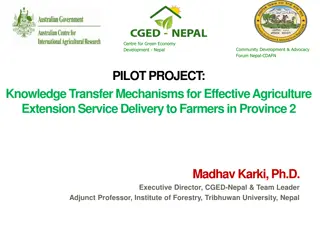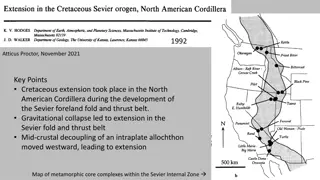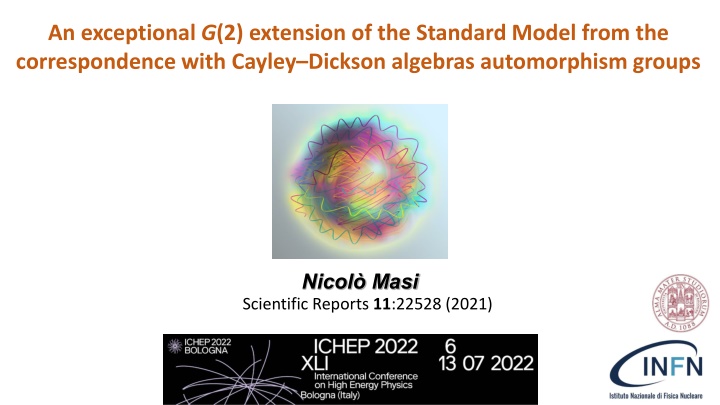
Exceptional G(2) Extension from Cayley Dickson Algebras Automorphism Groups
"Explore the exceptional G(2) extension of the Standard Model through Cayley Dickson algebras, delve into the automorphism search, and discover the potential of strong sector gauge theories broken by additional Higgs mechanisms. Unveil the exotic bosonic content and delve into the realms of dark matter and hypercomplex algebras beyond the Standard Model."
Download Presentation

Please find below an Image/Link to download the presentation.
The content on the website is provided AS IS for your information and personal use only. It may not be sold, licensed, or shared on other websites without obtaining consent from the author. If you encounter any issues during the download, it is possible that the publisher has removed the file from their server.
You are allowed to download the files provided on this website for personal or commercial use, subject to the condition that they are used lawfully. All files are the property of their respective owners.
The content on the website is provided AS IS for your information and personal use only. It may not be sold, licensed, or shared on other websites without obtaining consent from the author.
E N D
Presentation Transcript
An exceptional G(2) extension of the Standard Model from the correspondence with Cayley Dickson algebras automorphism groups Nicol Masi Scientific Reports 11:22528 (2021)
Summary 1. The algebraic conjecture: the automorphism search 2. Developing a broken G(2) gauge theory for the strong sector 3. Describing the exotic bosonic content A strong G(2) gauge theory broken by an additional Higgs mechanism is achievable Exceptional- colored gluons/glueballs as dark matter ??? ?(1) ??? ??(2) ??? ? ??(3) ???(??) select the SM groups Beyond SM with hypercomplex algebras Richer spectrum
Complex numbers symmetry ?(1) Cayley Cayley- -Dickson Dickson construction new new imaginary imaginaryunits units. There are three complex division construction: one can build up a sequence divisionalgebras sequence of of larger larger and and larger larger algebras algebras, , adding adding algebras, complex numbers, quaternions, and octonions We know can be applied to many aspects of real life, especially in electromagnetism: Riemann-Silberstein field reformulation of the electromagnetism, in terms of a complex vector that combines the electric and the magnetic field, can put in evidence this essential relation: The group U(1), the smallest compact real Lie group, corresponds to the circle group ?1, consisting of all complex numbers with absolute value 1 under multiplication, which is isomorphic to the SO(2) group of rotation: = The n n complex matrices which leave the scalar product invariant form the group:
Quaternions ??(2) Quaternions were first described by W. R. Hamilton in 1843 and applied to mechanics in three-dimensional space There is a strong relation between quaternion units and Pauli matrices: Spin/isospin group language Quaternionic basis The Lie algebras so(3) and su(2) are isomorphic and ??? = ?? 3 , where SO(3) is homomorphic to SU(2)
Cayley numbers: largest non-associative division algebra ?(2) ?1?2= ?4 ?1?3= ?7 . ??? ? = ? 2 the exceptional G(2) group is certainly much bigger than Standard Model SU(3), as it includes SU(3) and is equipped with six additional generators The only difference between octonions and sedenions automorphism groups is a factor of the permutation group ??: Sedenions: the archetype of generalized non division algebras The underlying symmetry is always G(2): the higher Cayley-Dickson algebras only add additional trialities, i.e. copies of G(2).
The conjecture The fundamental symmetry of the Standard Model of particle physics with N = 3 fermion families might be the realization of a tensor product between the Cayley-Dickson algebras Strong Families Fundamental forces might be isomorphic to the automorphisms groups: EW A new particle content come from difference between G(2) and SU(3): no more physics is needed nor predicted, except for the six additional degrees of freedom/generators/boson fields This is a simple algebraic criterion to predict physics beyond the SM, alternative to Higgs Naturalness and the Wimp Miracle
2. A G(2) gauge theory for the strong sector: why? The strong force acquires an enlarged exceptional-colored dynamics: to recover standard SU(3) color strong force description, the G(2) color sector should be broken by a Higgs-like mechanism and separated into two parts, one visible and the other excluded from the dynamics. G(2) is of particular interest because it is a compact (semi)simple Lie group of rank 2 like SU(3), it s the simplest exceptional group and it has a trivial center (the identity). It can be also used to mimic QCD in lattice simulations, avoiding the so-called sign problem (or complex action problem) which afflicts SU(3) and prevents Montecarlo integration. Six additional generators can be found studying the root and weight diagrams of the group. G(2) long roots coincide with SU(3) ones.
G(2) representation and particle content Fundamental (for fermions): Adjoint (for bosons): G(2) gluons ensemble is made of SU(3) gluons {8} plus six additional gluons which have SU(3) quark and anti-quark color quantum numbers Products/composite particle content: diquarks (J=0,1) baryons tetra, penta and exaquarks q-g hybrids (J=1/2) glueballs
G(2)-Higgs Lagrangian Field strength: Yang-Mills Lagrangian: Vector potential: G(2) Yang Mills theory is asymptotically free like all non-Abelian SU(N) gauge theories, with confinement at low energies Covariant derivative: The Higgs mechanism in action Quadratic scalar potential: Real-valued Higgs-like field: Vev: Plugging the vev into the square of the Higgs covariant derivative we get the usual quadratic term: 6 massless Goldstone bosons are eaten and become the longitudinal components of G(2) vector gluons Diagonal mass matrix for the gauge bosons: 1 extra Higgs (from the expansion of the potential about its minimum)
3. G(2)-Glueballs as DM candidates The breaking of the string between two static G(2) quarks happens due to the production of two triplets of G(2) gluons which screen the quarks The larger is ??, the greater is the distance where string breaking occurs: when ? , so that the 6 massive G(2) gluons are completely removed from the visible dynamics, the scale is infinite and the usual SU(3) string potential reappears. G(2) gluons are electrically neutral and can be immune to interactions with light and weak W, Z bosons at tree level and no additional families are added to the Standard Model: is this a good scenario for a cold dark matter? Lightest glueball states Conditio sine qua non: ??> ??? 1. An accidental symmetry: a conserved additive gluon number to prevent the decay into mesons (like B for protons) 2. Global discrete ??(or ??) symmetry: DM is odd under the new symmetry while SM fields are assumed to be even 3. G-parity conservation for a generic Yang Mills theory, to prevent decay into G-even SM particles (unlike ?)
G(2)-glueballs cosmology and stars The usual WIMP-like scenario built via the freeze-out mechanism cannot be achieved, since these gluons are never in thermal equilibrium with the baryon-photon fluid in the early Universe: we can invoke a FIMP scenario (???~10 (10 9)) and a SIMP (??> 103) Dark freez-out with number changing processes Exotic-Higgs portal: To build up a massive boson star, a repulsive quartic self- interaction needed to inward gravitational force: Tiny balls of glueballs potential balance is Solar mass objects with a neutron star-like radius the Perturbativity: Hypothetical binary gluons stars could be disentangled from a binary black hole system, due to differences in the gravitational wave frequency and amplitude and in the mass-radius relation Bullet Cluster self-interaction constraint In extremely high pressure and temperature astrophysical phases, unbroken G(2) can rearrange known QCD
Conclusions Fundamental microscopic forces might be manifestation of the conceivable algebras that can be built via the Cayley- Dickson process The automorphism correspondence higlights the mismatch between SU(3) strong force and octonions: the automorphism group is the exceptional group G(2), which is not exhausted by SU(3). In their difference new physics lies, in the form of six additional massive bosons, potentially disconnected by Standard Model dynamics: the exceptional- colored G(2) gluons When the Universe cooled down, reaching a proper far beyond TeV energy scale at which G(2) becomes broken, usual SU(3) QCD appeared, while an extra Higgs mechanism produced a secluded sector of cold bosonic states A minimal additional particle content for a minimal SM extension Sedenions show an additional property: they still have G(2) as a fundamental automorphism, but tripled by an ?3 factor, which resembles the three fermion families of the Standard Model and its ?3 invariant extension G(2) could guarantee peculiar manifestations in extreme astrophysical compact objects, such as boson stars made of G(2) glueballs, which can populate the dark halos and be observed in the future studying their gravitational waves and dynamics.
Thank you! Scientific Reports 11:22528 (2021) Nicol Masi

